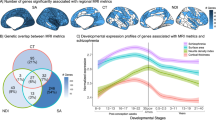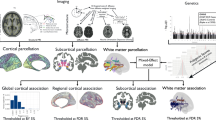Abstract
There is an urgent need to decipher the complex nature of genotype-phenotype relationships within the multiple dimensions of brain structure and function that are compromised in neuropsychiatric syndromes such as schizophrenia. Doing so requires sophisticated methodologies to represent population variability in neural traits and to probe their heritable and molecular genetic bases. We have recently developed and applied computational algorithms to map the heritability of, as well as genetic linkage and association to, neural features encoded using brain imaging in the context of three-dimensional (3D), population-based, statistical brain atlases. One set of algorithms builds on our prior work using classical twin study methods to estimate heritability by fitting biometrical models for additive genetic, unique, and common environmental influences. Another set of algorithms performs regression-based (Haseman-Elston) identical-bydescent linkage analysis and genetic association analysis of DNA polymorphisms in relation to neural traits of interest in the same 3D population-based brain atlas format. We demonstrate these approaches using samples of healthy monozygotic (MZ) and dizygotic (DZ) twin pairs, as well as MZ and DZ twin pairs discordant for schizophrenia, but the methods can be generalized to other classes of relatives and to other diseases. The results confirm prior evidence of genetic influences on gray matter density in frontal brain regions. They also provide converging evidence that the chromosome 1q42 region is relevant to schizophrenia by demonstrating linkage and association of markers of the Transelin-Associated-Factor-X and Disrupted-In-Schizophrenia-1 genes with prefrontal cortical gray matter deficits in twins discordant for schizophrenia.
Similar content being viewed by others
References
Abecasis G. R., Cardon L. R., Cookson, W. O., et al. (2000) A general test of association for quantitative traits in nuclear families. Am. J. Hum. Genet. 66(1), 279–292.
Baare, W. F., Hulshoff Pol, H. E., Boomsma, D. I., et al. (2001) Quantitative genetic modeling of variation in human brain morphology. Cereb. Cortex 11(9), 816–824.
Bearden, C. E., Hoffman K. M., Cannon, T. D., et al. (2001) The neuropsychology and neuroanatomy of bipolar affective disorder: a critical review. Bipolar Disord. 3(3), 106–150.; discussion 151–153.
Cannon, T. D., Hennah, W., et al. (2005) DISC1/TRAX haplotypes associated with schizophrenia, reduced prefrontal gray matter, and impaired short- and long-term memory. Arch. Gen. Psychiatr. 62, 1205–1213.
Cannon, T. D., Huttunen, M. O., Lonnqvist, J., et al. (2000) The inheritance of neuropsychological dysfunction in twins discordant for schizophrenia. Am. J. Hum. Genet. 67 (2), 369–382.
Cannon, T. D., Kaprio, J., Lonnqvist, J., Huttunen, M., and Koskenvuo, M. (1998) The genetic, epidemiology of schizophrenia in a Finnish twin cohort. A population-based modeling study. Arch. Gen. Psychiatr. 55(1), 67–74.
Cannon, T. D., Thompson, P. M., van Erp, T. G., et al. (2002) Cortex mapping reveals regionally specific patterns of genetic and disease-specific gray-matter deficits in twins discordant for schizophrenia. Proc. Natl. Acad. Sci. USA 99(5), 3228–3233.
Carmelli, D., Reed, T., DeCarli, C., et al. (2002) Abivariate genetic analysis of cerebral white matter hyper-intensities and cognitive performance in elderly male twins. Neurobiol. Aging 23 (3), 413–420.
Ekelund, J., Hennah, W., et al. (2004) Replication of 1q42 linkage in Finnish schizophrenia pedigrees. Mol. Psychiatr. 9(11), 1037–1041.
Elston, R. C., Buxbaum, S., Jacobs, K. B., and Olson J. M. (2000) Haseman and Elston revisited. Genet. Epidemiol. 19(1), 1–17.
Frackowiak, R. S. J., Friston, K. J., et al. (1997) Human brain Function. Academic Press, San Diego.
Gasperoni, T. L., Ekelund, J., Huttunen, M., et al. (2003) Genetic linkage and association between chromosome 1q and working memory function in schizophrenia. Am. J. Med. Genet. 116B(1), 8–16.
Gray, J. R. and Thompson P. M. (2004) Neurobiology of intelligence: science and ethics. Nat. Rev. Neurosci. 5(6), 471–482.
Hennah, W., Varilo, T., Kestila, M., et al. (2003) Haplotype transmission analysis provides evidence of association for DISC1 to schizophrenia and suggests sex-dependent effects. Hum. Mol. Genet. 12(23), 3151–3159.
Hovatta, I., Varilo, T., Suvisaari, J., et al. (1999) A genomewide screen for schizophrenia genes in an isolated finnish subpopulation, suggesting multiple susceptibility loci. Am. J. Human Genet. 65, 1114–1124.
Hurdal, M. K. and Stephenson, K. (2004) Cortical cartography using the discrete conformal approach of circle packings. Neuroimage 23(Suppl 1), S119-S128.
James, R., Adams, R. R., Christie, S., Buchanan, S. R., Porteous, D. J., and Miller, J. K. (2004) Disrupted in Schizophrenia 1 (DISC1) is a multicompartmentalized protein that predominantly localizes to mitochondria. Mol. Cell Neurosci. 26(1), 112–122.
Kruglyak, L. and Lander, E. S. (1995) Complete multipoint sib-pair analysis of qualitative and quantitative traits. Am. J. Hum. Genet. 57(2), 439–454.
Mangin, J. F., Riviere, D., Cachia, A., et al. (2004) A framework to study the cortical folding patterns. Neuroimage 23(Suppl 1.), S129-S138.
Merikangas, K. R., Chakravarti, A., Moldin, S. O., et al. (2002) Future of genetics of mood disorders research. Biol. Psychiatr. 52 (6), 457–477.
Millar, J. K., Christie, S., and Porteous, D. J (2003) Yeast two-hybrid screens implicate DISC1 in brain development and function. Biochem. Biophys. Res. Commun. 311(4), 1019–1025.
Millar, J. K., Wilson-Annan, J. C., Anderson, S., et al. (2000) Disruption of two novel genes by a, translocation co-segregating with schizophrenia. Hum. Mol. Genet. 9(9), 1415–1423.
Miyoshi, K., Honda, A., Baba, K., et al. (2003) Disrupted-In-Schizophrenia 1, a candidate gene for schizophrenia, participates in neurite outgrowth. Mol. Psychiatr. 8(7), 685–694.
Morris, J. A., Kandpal, G., Ma, L., Austin, C. P. (2003) DISC1 (Disrupted-In-Schizophrenia 1) is a centrosome-associated protein that interacts with MAP1A, MIPT3, ATF4/5 and NUDEL: regulation and loss of interaction with mutation. Hum. Mol. Genet. 12(13), 1591–1608.
Neale, M. C. and Cardon, L. R. (1992) Methodology for Genetic Studies of Twins and Families. Kluwer Academic Publishers, Dordrecht, Netherlands.
Owen, M. J., Williams, N. M., O'Donovan, M. C., et al. (2004) The molecular genetics of schizophrenia: new findings promisenew insights. Mol. Psychiatr. 9(1), 14–27.
Plomin, R. and Kosslyn, S. M. (2001) Genes, brain and cognition. Nat. Neurosci. 4(12), 1153–1154.
Posthuma, D., De Geus, E. J., Baare, W. F., HulshoffPol, H. E., Kahn, R. S., and Boomsma, D. I. (2002) The association between brain volume and intelligence is of genetic origin. Nat. Neurosci. 5(2), 83–84.
Rasser, P. E., Johnston, P. J., et al. (2005) BOLD activation during the tower of London task using gyral pattern and intensity averaging models of cerebral cortex. Neuroimage 26(3), 941–951.
Rocchi, A., Pellegrini, S., Siciliano, G., and Murri, L. (2003) Causative and susceptibility genes for Alzheimer's disease: a review. Brain Res. Bull. 61(1), 1–24.
Thompson, P. M., Cannon, T. D., Narr, K. L., et al. (2001a) Genetic influences on brain structure. Nat. Neurosci. 4(12), 1253–1258.
Thompson, P. M., Hayashi, K. M., Sowell, E. R., et al. (2004) Mapping cortical change in Alzheimer's disease, brain development, and schizophrenia. Neuroimage 23(Suppl 1), S2-S18.
Thompson, P. M., Mega, M. S., Woods, R. P., et al. (2001b) Cortical change in Alzheimer's disease detected with a disease-specific population-based brain atlas. Cereb. Cortex 11(1), 1–16.
Thompson, P. M., Rapoport, J. L., et al. (2003) Automated analysis of structural MRI data. Brain Imaging in Schizophrenia. D. Weinberger, Oxford University Press
Thompson, P. M. and Toga, A. W. (2002) A framework for computational anatomy. Comput. Vis. Sci. 5, 1–12.
Thompson, P. M., Woods, R. P., Mega, M. S., and Toga, A. W. (2000) Mathematical/computational challenges in creating deformable and probabilistic atlases of the human brain. Hum. Brain Mapp. 9(2), 81–92.
Tosun, D., Rettmann, M. E., Han, X., et al. (2004) Cortical surface segmentation and mapping. Neuroimage 23(Suppl 1), S108-S118.
Turkheimer, E., Haley, A., Waldron, M., D'Onofrio, B., and Gottesman, II. (2003) Socioeconomic status modifies heritability of IQ in young children. Psychol. Sci. 14(6), 623–628.
van Erp, T. G., Saleh, P. A., Huttunen, M., et al. (2004) Hippocampal volumes in schizophrenic twins. Arch. Gen. Psychiatr. 61(4), 346–353.
Van Essen, D. C. (2004) Surface-based approaches to spatial localization and registration in primate cerebral cortex. Neuroimage 23(Suppl 1), S97-S107.
Worsley, K. J., Andermann, M., Koulis, T., MacDonald, D., and Evans, A. C. (1999) Detecting changes in nonisotropic images. Hum. Brain Mapp. 8(2–3), 98–101.
Zeineh, M. M., Engel, S. A., Thompson, P. M., Bookheimer, S. Y., et al. (2003) Dynamics of the hippocampus during encoding and retrieval of face-name pairs. Science 299(5606), 577–580.
Author information
Authors and Affiliations
Corresponding author
Rights and permissions
About this article
Cite this article
Cannon, T.D., Thompson, P.M., van Erp, T.G.M. et al. Mapping heritability and molecular genetic associations with cortical features using probabilistic brain atlases. Neuroinform 4, 5–19 (2006). https://doi.org/10.1385/NI:4:1:5
Issue Date:
DOI: https://doi.org/10.1385/NI:4:1:5




